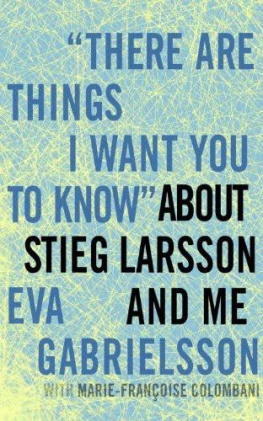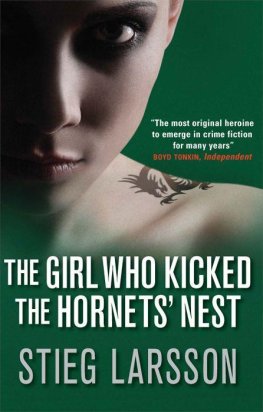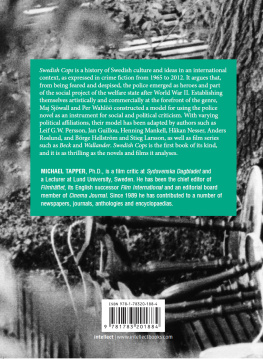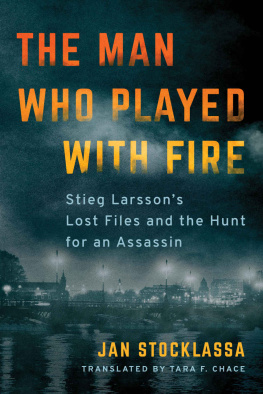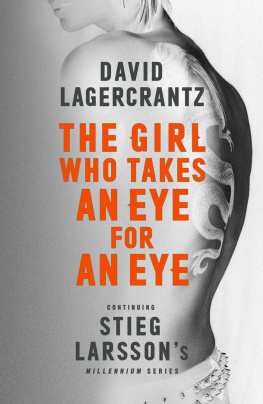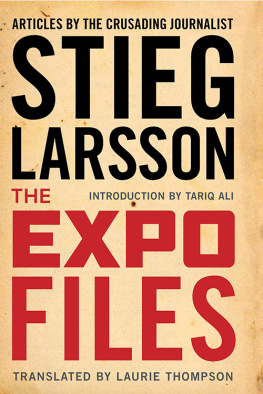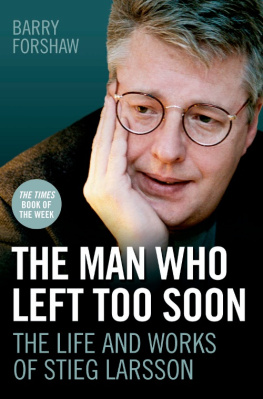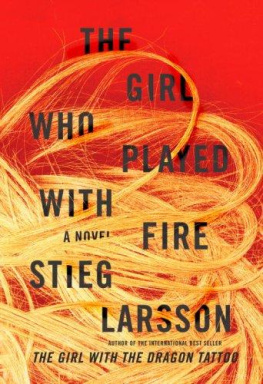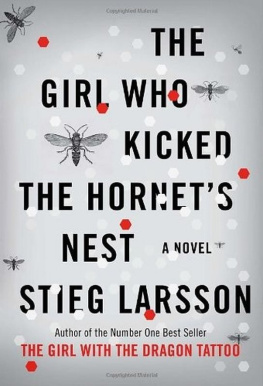Eva Gabrielsson - There Are Things I Want You to Know about Stieg Larsson and Me
Here you can read online Eva Gabrielsson - There Are Things I Want You to Know about Stieg Larsson and Me full text of the book (entire story) in english for free. Download pdf and epub, get meaning, cover and reviews about this ebook. year: 2011, publisher: Seven Stories Press, genre: Non-fiction. Description of the work, (preface) as well as reviews are available. Best literature library LitArk.com created for fans of good reading and offers a wide selection of genres:
Romance novel
Science fiction
Adventure
Detective
Science
History
Home and family
Prose
Art
Politics
Computer
Non-fiction
Religion
Business
Children
Humor
Choose a favorite category and find really read worthwhile books. Enjoy immersion in the world of imagination, feel the emotions of the characters or learn something new for yourself, make an fascinating discovery.
- Book:There Are Things I Want You to Know about Stieg Larsson and Me
- Author:
- Publisher:Seven Stories Press
- Genre:
- Year:2011
- Rating:4 / 5
- Favourites:Add to favourites
- Your mark:
- 80
- 1
- 2
- 3
- 4
- 5
There Are Things I Want You to Know about Stieg Larsson and Me: summary, description and annotation
We offer to read an annotation, description, summary or preface (depends on what the author of the book "There Are Things I Want You to Know about Stieg Larsson and Me" wrote himself). If you haven't found the necessary information about the book — write in the comments, we will try to find it.
There Are Things I Want You to Know about Stieg Larsson and Me — read online for free the complete book (whole text) full work
Below is the text of the book, divided by pages. System saving the place of the last page read, allows you to conveniently read the book "There Are Things I Want You to Know about Stieg Larsson and Me" online for free, without having to search again every time where you left off. Put a bookmark, and you can go to the page where you finished reading at any time.
Font size:
Interval:
Bookmark:
Marie-Francoise Colombani would like to thank: Eva Gabrielsson, for her trust
Regis Boyer, specialist in Scandinavian literature and civilization, and Gunnar Lund, the Swedish ambassador to France, for their valuable assistance
H. Poussin, for his support and ornithological expertise Michelle Fitoussi, an early and devoted fan of
The Millennium Trilogy, for her knowledge of building construction and Bruno Lafforgue for his patience.
SEVEN STORIES PRESS is an independent book publisher based in New York City. We publish works of the imagination by such writers as Nelson Algren, Russell Banks, Octavia E. Butler, Ani DiFranco, Assia Djebar, Ariel Dorfman, Coco Fusco, Barry Gifford, Hwang Sok-yong, Lee Stringer, and Kurt Vonnegut, to name a few, together with political titles by voices of conscience, including the Boston Womens Health Collective, Noam Chomsky, Angela Y. Davis, Human Rights Watch, Derrick Jensen, Ralph Nader, Loretta Napoleoni, Gary Null, Project Censored, Barbara Seaman, Alice Walker, Gary Webb, and Howard Zinn, among many others. Seven Stories Press believes publishers have a special responsibility to defend free speech and human rights, and to celebrate the gifts of the human imagination, wherever we can. For additional information, visit www.sevenstories.com.
PEOPLE OFTEN ask me if the Swedish drink as much coffee as the characters do in The Millennium Trilogy. Well, we drink a lot of it indeed, given that Finland is the only country in the world that consumes more coffee than we do. And if I had to single out just one thing in common between Stieg Larsson and Mikael Blomkvist, it would surely be their impressive daily quota of coffee.
Stieg and I shared this addiction, which dates from our childhood. (Stiegs grandmother began giving him coffee openly when he was five, when children ordinarily drink milk; my grandmother did the same with me, but more discreetly, since my mother was still around.) Coffee was for both of us an extraordinary remedy for all kinds of misfortunes great or small. Synonymous with intimacy, conviviality, hospitality, it accompanied our moments of happiness as well as our long, long conversations with each other or friends. In the course of our thirty-two years together, I think we were largely responsible for the Swedish coffee industrys handsome profits! Although we experimented with every possible way of preparing the brew, we always fell back on percolated coffee. In our home, a coffeepot sat permanently on the stove.

THESE DAYS , I dont fix coffee for myself anymore. Its silly to fill only half a coffeepot. Besides, the empty half means that Stieg will never again look at me over the rim of his cup, his eyes twinkling with curiosity, like a child whos just been given a present. Never again will I hear him say, So, tell me: What did you do today? What new things have you discovered?
In The Millennium Trilogy, Lisbeth Salander sometimes breaks off a discussion with Mikael Blomkvist by saying, Ill think about it. The first time I read that, I burst out laughing! Whenever Stieg and I reached an impasse during a serious argument because I wouldnt adopt his point of view, I always wound up saying those same words. They meant that it was time to move on to a more neutral and pleasant conversation, so at this signal, one of us would immediately get up to go make a pot of coffee, and wed be friends again.
Nowadays I never drink coffee at home by myself.
Ive switched to tea.

THIS BOOK I wish I hadnt had to write it. It talks about Stieg, and our life together, but also about my life without him.
A heart attack took him from me on November 9, 2004. An accursed day for me, and for many others in the past as well, to whom it brought tremendous tragedy. Im thinking of November 9, 1938: Kristallnacht, the Night of Broken Glass, when the Nazis drew one step closer to the Final Solution by attacking their Jewish fellow citizens. Stieg always commemorated Kristallnacht by participating in public events. On that evening of November 9, 2004, he was to have given a lecture at the headquarters of the ABF (Arbetarnas Bildningsforbund), the Workers Educational Association, in Stockholm.
Because of my work as an architect, I was not with Stieg when he died but in the province of Dalarna, in central Sweden. Would it have made any difference if I had been there? Ill never know, obviously, but I like to believe so. Whenever we were together, that communion affected our lives profoundly.

MILLENNIUM STIEG , the author of best-selling crime thrillers, was born in July 2005 with the publication of the first novel in his trilogy. Since then there have been feature films and TV movies.
And yet, the trilogy is only one episode in Stiegs journey through this world, and it certainly isnt his lifes work.
The Stieg of the Millennium industry doesnt interest me.
The one I care about is my life partner and my ally in everything. The man I loved deeply, with whom I went through life for thirty-two years. An affectionate man, generous, funny, enthusiastic, committed. The journalist, the feminist, the militant. The love of my life.
When I lost him, a huge part of me was lost with him.

THAT STIEG was born on August 15, 1954.
IN THEGirl with the Dragon Tattoo, the novel that opens The Millennium Trilogy, Mikael Blomkvist discovers a photo taken during the Childrens Day Parade in Hedeby, the oldest neighborhood in the small town of Hedestad, on the day Harriet Vanger disappeared. Seeking information about that day to help him understand what might have frightened the teenager away, he hunts for the tourist couple who photographed the parade forty years earlier. His research takes him into northern Sweden, first to Norsjo, then to Bjursele, in Vasterbotten County. Why there? For most Swedes, those are godforsaken places at the back of beyond, but Stieg knew them well. It was there that he went as a baby in 1955 to live with his maternal grandparents. His father and mother, Erland Larsson and Vivianne Bostrom, were too young to bring him up properly, and they left to live 600 miles away in the south. In 1957 they moved again to Umea (pronounced Umio), a small city 125 miles southeast of Norsjo.
Writing about Norsjo and Bjursele was Stiegs way of paying homage to the small community of people there who gave him the best moments of his youth. And a way of thanking them for the values they instilled in him.

STIEG LIVED with his grandparents in a small wooden house on the edge of a forest. Their home had a kitchen and one other room, without water, electricity, or an indoor toilet. This kind of house is typical of the Swedish countryside and its family farms, and in those days, when the next generation took over the farm, the old folks would retire to such a place. The walls of Stiegs grandparents house were poorly insulated, and the joints between the planks were probably crammed with sawdust in the old style. The kitchen woodstove on which his grandmother cooked the meals was the only source of heat. In the winter, the temperature outside could drop to as low as -35 degrees Celsius, withat mostthirty minutes of daylight, and Stieg used to ski cross-country to the village school in the moonlight. Prompted by his natural curiosity, he tirelessly explored the surrounding forests, lakes, and trails, hoping to meet other people and catch glimpses of animals, too. Life was tough where he lived, so it took plenty of ingenuity to survive, but such an environment breeds hardy individuals, self-reliant, resourceful, generous folks who can be counted on in a pinch. Like Stieg.
Font size:
Interval:
Bookmark:
Similar books «There Are Things I Want You to Know about Stieg Larsson and Me»
Look at similar books to There Are Things I Want You to Know about Stieg Larsson and Me. We have selected literature similar in name and meaning in the hope of providing readers with more options to find new, interesting, not yet read works.
Discussion, reviews of the book There Are Things I Want You to Know about Stieg Larsson and Me and just readers' own opinions. Leave your comments, write what you think about the work, its meaning or the main characters. Specify what exactly you liked and what you didn't like, and why you think so.

